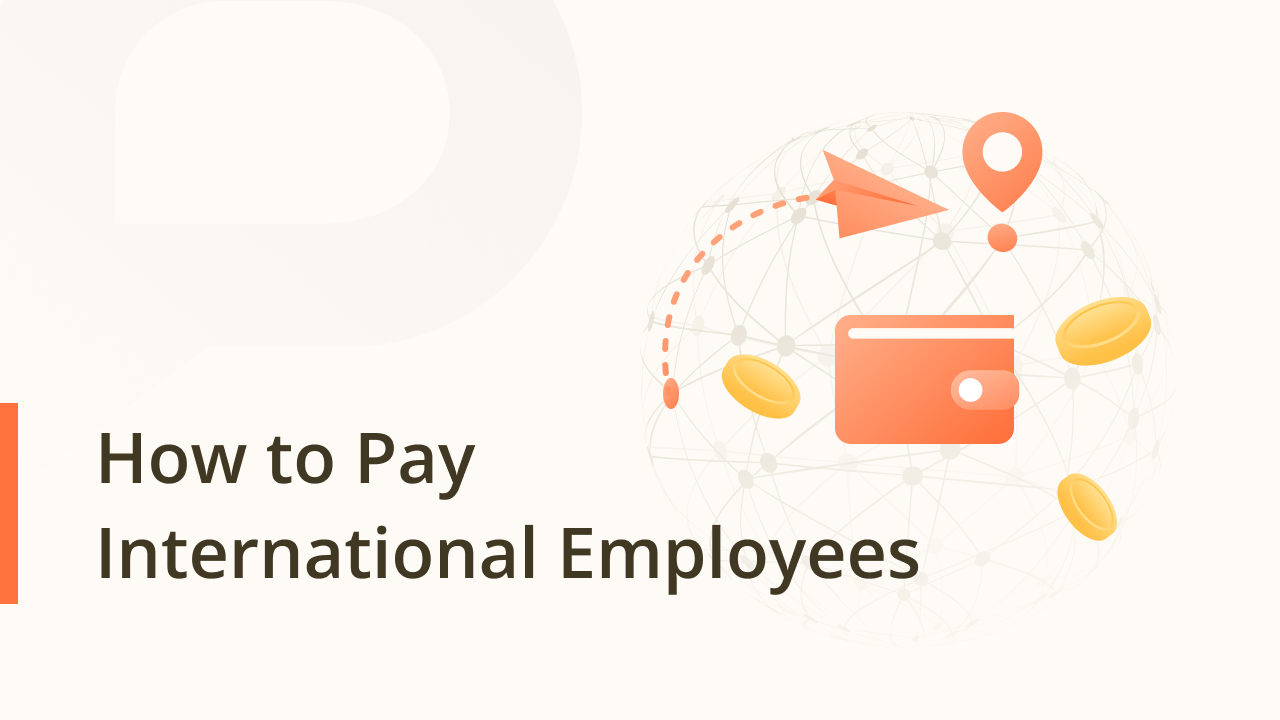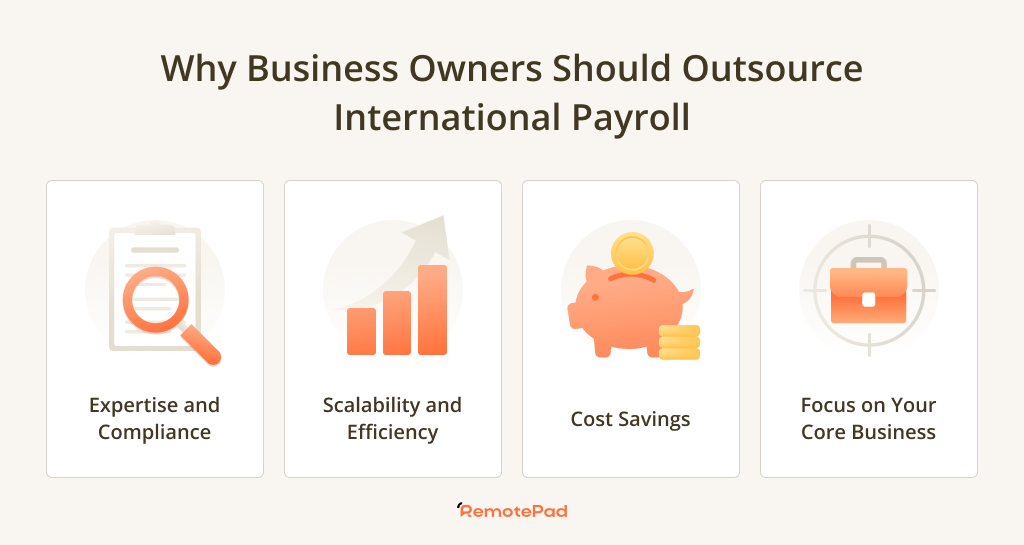Spending too much on recruitment, payroll or global HR?
We help you find the Best Providers at the lowest cost.
Paying international employees involves navigating a complex web of local labor laws, tax regulations, and international money transfer systems. Global expansion and the rise of remote work have made employers need to understand the intricacies of cross-border payments to their workforce – if you’ve been curious about how to pay international employees, you’re not alone. Companies must balance adhering to legal compliances and managing payroll efficiently to ensure timely and accurate compensation for their international employees.
Expanding your business internationally brings thrilling opportunities, but also the complexities of managing payroll across borders. Knowing how to pay international employees entails selecting the best payment method for your global team and ensuring timely compensation, cost control, and compliance with local regulations. Each approach offers unique advantages and potential hurdles, from online payment platforms to establishing local branches or partnering with an Employer of Record (EOR). Factors like currency conversion rates, transaction fees, and regulatory requirements need careful consideration. If you have been considering expanding internationally, you need to know how to pay international employees. Let’s dive in!
Key Takeaways
- Knowing how to pay international employees in full compliance with local labor laws and tax regulations is crucial for companies running international payroll.
- Employers have multiple payment methods for international employees to choose from.
- Effective payroll management requires balancing compliance and operational efficiency.
How to Pay International Employees
To manage a global team effectively, it is crucial to understand the intricacies of international payroll, including adhering to varying tax and labor laws and executing the payroll process. Indeed, these are vital first steps in knowing how to pay international employees.
Global Payroll Basics
International payroll encompasses organizations’ methods and processes for compensating international employees. It involves converting and delivering salaries in different currencies, managing benefits, and ensuring accurate tax withholding and payment. A payroll process for global talent must adapt to handle these complexities, considering factors such as exchange rate fluctuations and cross-border payment systems.
One key consideration in knowing how to pay international employees is the decision on payment method. Companies often have to decide whether to set up a legal entity in each country they operate in or to employ global payroll partners who can streamline payroll services for them. Either way, the goal remains consistent: to pay employees on time and comply with all applicable payroll laws.
Compliance with International Labor and Tax Laws
Part of the challenge in ensuring your team knows how to pay international employees is processing payments and ensuring compliance with labor and tax laws that differ significantly from country to country. International employers must know local laws dictating minimum wage levels, working hours, and benefits entitlement. They must also adhere to tax compliance requirements that regulate the withholding and remittance of taxes to local authorities.
This often means creating a tailored payroll process for multinational companies that respects each country’s regulations. Failure to do so can result in significant penalties and damage relations with local governments and global talent. Therefore, due diligence is critical to complying with international payroll laws and maintaining the organization’s reputation.
Setting Up Payment Infrastructure
Businesses must consider various administrative and legal frameworks when compensating international employees. The following subsections guide employers in selecting suitable mechanisms for international payroll processes.
Choosing a Payroll Provider
Employers should look for a payroll provider that specializes in international payment services. The chosen provider should be capable of navigating currency exchange and international banking regulations and have features that facilitate easy and accurate payment to overseas staff. It is essential to assess their platform’s integration capabilities with existing systems and to ensure data security is a top priority.
Important Considerations:
- Currency exchange: Handling multiple currencies and exchange rates.
- Regulatory compliance: Adherence to international banking and tax laws.
- Integration: Compatibility with existing HR and accounting software.
Employer of Record Services
An Employer of Record (EOR) service can simplify paying international employees. An EOR acts as a legal entity that officially employs the staff on behalf of the company and is responsible for compliance with local labor laws. This is a viable option for organizations that wish to hire internationally but want to avoid the complexities of creating their foreign subsidiary.
Key Elements:
- Compliance: EOR ensures adherence to local employment regulations.
- Efficiency: Streamlines the payroll process without establishing a local entity.
Creating a Legal Entity
Establishing a local entity or a foreign subsidiary can benefit businesses planning a long-term or significant presence in a foreign country. This involves a more substantial commitment but provides greater control over operations and payment processes. Creating a legal entity requires navigating complex legal terrain and varies widely depending on country-specific laws.
Steps Involved:
- Registration: Officially registering the business according to local laws.
- Compliance management: Adhering to country-specific labor and tax regulations.
Table of Country Specifics: (Hypothetical Example)
| Country | Time to Establish | Initial Cost Estimate | Compliance Complexity |
|---|---|---|---|
| Country A | 3 months | $20,000 | High |
| Country B | 6 weeks | $15,000 | Moderate |
| Country C | 5 months | $30,000 | Very High |
Managing Payments and Currencies
Companies must navigate the complexities of handling multiple currencies and understanding the associated exchange rates and fees when paying international employees. This financial management is critical to ensuring both compliance and cost-effectiveness.
Understanding the details, such as the components of a paystub, is essential when setting up payroll systems for international employees. This includes accommodating different currency conversions and complying with various international tax laws.
Handling Multiple Currencies
Paying international employees often involves transactions in various currencies. Businesses must set up multicurrency bank accounts or use payment platforms that support currency conversions. Choosing solutions that offer competitive currency exchange rates and minimal currency exchange fees is essential. For instance, using a trusted global partner can ease these transactions by providing services tailored for international payroll, reducing the burden of managing different currencies in-house.
Understanding Exchange Rates and Fees
Fluctuating exchange rates can significantly impact the cost of paying international employees. Companies need to monitor currency exchange rates closely and strategize their transactions to reduce costs associated with currency conversions. While secure and commonly used, SWIFT payments may come with higher fees. Therefore, employers should compare various services, understanding the fees and exchange rates provided, to ensure employees receive their correct salaries without excess costs. For example, platforms like Wise provide detailed guides on managing these payments efficiently while maintaining transparency about the costs involved.
Employment Types and Contracts
When expanding a business internationally, employers must decide between hiring full-time employees or independent contractors. This decision significantly affects employment contracts, tax obligations, and labor law compliance.
Full-Time Employees and Contractors
Full-time employees are typically integrated into the company’s structure, receiving benefits, a steady income, and protections under the host country’s labor laws. Employers must navigate international labor laws, including minimum wage compliance, working hours, and overtime compensation. The employment relationship is ongoing, and both sides expect continuity and commitment.
On the other hand, Independent Contractors offer employers a more flexible working arrangement. Hiring independent contractors can be cost-effective as they are not entitled to company benefits and are responsible for their own tax obligations. However, it is crucial to clearly define the nature of the work and duties to avoid misclassification, which can lead to legal complications.
Drafting Employment Contracts
For Employment Contracts, specificity is key. Contracts should clearly outline the employee’s role, responsibilities, compensation, benefits, and the conditions under which the contract may be terminated. When drafting these documents, it is imperative to ensure they adhere to local employment laws and international labor standards.
Hiring Contractors necessitates a different approach to contracts. The agreement should detail the project scope, payment terms, deadlines, and intellectual property rights. It should also clarify that the contractor is responsible for their own tax and legal obligations to affirm the remote employment relationship is indeed that of a contractor, not an employee.
Understanding these distinctions is foundational for any company looking to hire internationally, whether remotely or in-country, to ensure legal compliance and to build transparent, fair employment practices.
Operational Considerations
In managing the operational complexities of compensating international employees, employers must prioritize selecting appropriate payment methods and the efficiency of their payroll processes.
Choosing Payment Methods
When determining payment methods for international employees, companies should evaluate the currency exchange rates and transfer fees associated with each option. Moreover, businesses must ensure they comply with the financial regulations of the employee’s country. Options like wire transfers, international ACH, and payment services like Wise can facilitate quick payments and offer convenience for remote work scenarios.
Processing Payroll Efficiently
Efficient processing of payroll is critical to ensure timely and accurate wage distribution. This requires robust systems that handle invoicing and payroll schedules across different time zones and banking practices. Employers should use payment methods that allow for batch processing and scheduling to minimize operational delays and guarantee consistent payment cycles for employees working in various locations around the globe.
Legal and Compliance Challenges
When paying international employees, businesses must navigate legal and compliance challenges. These hurdles are significant because they involve local and international laws, and missteps can lead to severe penalties.
Adhering to Local and International Regulations
Companies must ensure compliance with local laws in each country where they have employees. This includes understanding and adhering to local labor laws, which can vary significantly from one country to another. For instance, labor laws will dictate minimum wage requirements, maximum working hours, mandatory benefits, and taxation procedures. International payroll solutions must also cater to myriad legal requirements that can radically differ across borders.
- Compliance:
- Registering with local tax authorities
- Honoring collective bargaining agreements
- Respecting privacy and data protection laws
Failure to comply with these regulations can result in fines, legal action, and damage to the company’s reputation. Businesses must work with local experts or employ comprehensive services knowledgeable about borderless payroll guide solutions.
Mitigating Risks of Misclassification
The risks of misclassification present a substantial legal challenge. To prevent legal ramifications, businesses must correctly classify workers as employees or independent contractors. Misclassification can lead to:
- Incorrect tax filings
- Unpaid benefits and leave entitlements
- Legal penalties
Companies must understand the distinction and maintain clear records supporting their chosen classification. A thorough understanding of the local standards, perhaps enlisting the help of organizations specializing in global employment outsourcing, can mitigate the risk associated with the misclassification of international employees.
Cultural and Geographical Considerations
Companies must consider cultural and geographical influences when addressing the payment of international employees. These factors significantly affect how compensation is structured, and how foreign employees perceive it.
Navigating Cultural Differences
Understanding and respecting cultural differences is pivotal in managing a global workforce. Regulations around compensation, working hours, and customary benefits can vary drastically from one country to another, reflecting local customs and economic conditions. For instance, common bonus structures in the United States might hold different values in other countries. Additionally, adapting to cultural differences may involve recognizing and observing local holidays, understanding appropriate communication styles, and providing culturally relevant benefits.
Local Partnerships and Global Talent Acquisition
Forging local partnerships is an advantageous strategy for companies seeking to enrich their global talent pool. Local partners can offer invaluable insights into new markets’ legal and cultural landscapes, facilitating smoother integration of international talent. These collaborations may range from joint ventures with local businesses to consulting with in-country experts to ensure compliance with local employment regulations. Specifically, when it comes to compensating overseas employees, such partnerships can assist in navigating tax codes, labor laws, and payroll systems, which can be intricate and varied. Engaging with local partner entities allows businesses to attract and retain foreign employees, reinforcing their commitment to a diverse and inclusive global workplace.
Financial Management and Planning
Successful financial management and planning ensure an organization can navigate the complexities of paying international employees effectively. It encompasses carefully considering budget constraints and the additional financial responsibilities such as insurance and benefits when compensating a globally dispersed workforce.
Budgeting for International Payroll
Budgeting for international payroll is a multi-faceted process. Companies must consider currency exchange rates, varying wage laws, and potential financial risks associated with global expansion. They should establish a clear budget that covers:
- Employee salaries may differ drastically between countries and are influenced by local market standards.
- Employer taxes and social security contributions vary by location.
- Administrative costs associated with managing payroll across different countries.
It is also crucial to plan for occasional fluctuations in currency exchange rates and consider a buffer within the budget to manage these changes without impacting the compensation package negatively.
Insurance and Benefits Planning
When it comes to insurance and creating a benefits package, companies must adhere to the various legal requirements in each country. This planning should include:
- Health insurance: Understanding the different healthcare systems and whether private insurance is necessary or supplemental.
- Providing retirement benefits in compliance with local regulations, which may involve setting up or contributing to pension schemes.
- Looking into other statutory benefits required by law, such as disability, unemployment, and life insurance.
Creating a competitive and comprehensive benefits package is essential for attracting and retaining talent during global expansion efforts. Companies must research and integrate these aspects into their overall financial planning for international employees.
Addressing Administrative Challenges
Companies face two significant administrative challenges when tackling the payment of international employees: maintaining accurate records and ensuring robust cybersecurity measures. These tasks are critical for effective payroll management and compliance with international regulations.
Maintaining Accurate Employee Records
Handling Payroll: The cornerstone of any payroll system, especially when dealing with payroll for international employees, is the accuracy and timeliness of employee records. Companies must ensure that:
- Each employee’s work hours, leave, and benefits are recorded meticulously.
- The payroll system aligns with the local labor laws and tax requirements.
- Currency exchange rates are updated and accurate to avoid payment discrepancies.
Accurate records are not just a matter of compliance but also foster trust between the employer and the employee, ensuring that workers are paid fairly and on time.
Ensuring Cybersecurity and Data Protection
Cybersecurity: As companies adopt digital solutions to manage their global payroll, the risk of cybersecurity breaches increases. Companies should:
- Implement robust data encryption protocols to protect sensitive information.
- Conduct regular security audits to identify and address vulnerabilities.
- Train employees in cybersecurity best practices to prevent data leaks.
Data protection is not only a legal obligation—with severe penalties for breach—but it is also crucial for safeguarding the company’s reputation and the personal information of its employees.
Advanced Payroll Techniques
When addressing the intricacies of compensating international team members, businesses employ advanced payroll techniques to optimize foreign exchange and leverage cutting-edge technology.
Foreign Exchange and Payment Optimization
To mitigate the impact of currency fluctuations and transaction fees, companies often partner with global payroll providers that offer specialized services in foreign exchange management. These providers enable businesses to secure more favorable exchange rates and reduce costs associated with international transfers. For example, employers can streamline the payroll process by utilizing payment platforms such as PayPal or Payoneer, offering tailored solutions for currency conversion and cross-border payments.
Key Considerations:
- Monitoring Exchange Rates: Regularly track and forecast currency trends to choose the right transaction time.
- Utilizing Forward Contracts: Lock in current exchange rates for future payments to avoid market volatility.
Leveraging Technology for Global Payroll
Employers can collaborate with Professional Employer Organizations (PEOs) to handle complexities associated with international payroll processing. These organizations use advanced payroll systems integrating labor law compliance, tax regulation, and employee benefits into a unified platform. By leveraging technology, global payroll partners provide efficient and accurate payroll services that can scale with the company’s expansion.
Benefits of Technology-Driven Payroll:
- Automation: Reduces the risk of errors and saves time on repetitive tasks.
- Compliance Assurance: Stays up-to-date with varying international regulations to ensure legal compliance.
By integrating these advanced payroll techniques, businesses can achieve a reliable and efficient process for compensating their international workforce.
Why Business Owners Should Outsource International Payroll
Navigating the labyrinth of global payroll can be a daunting task for business owners. Understanding how to pay international employees the right way involves meticulously tracking ever-changing regulations, navigating multiple currencies, and ensuring compliance with unfamiliar tax laws. Outsourcing your international payroll to a specialized provider can alleviate these burdens and streamline the entire process.
Here’s why outsourcing makes sense for many businesses:
Expertise and Compliance: Reputable payroll providers have in-depth knowledge of local labor laws, tax codes, and social security requirements. This ensures you remain compliant with even complex regulations when learning how to pay international employees. Their dedicated teams stay on top of any changes, so you and your HR department don’t have to become experts in dozens of different legal landscapes.
Scalability and Efficiency: As your business expands and you learn how to pay international employees in more countries, outsourcing becomes even more beneficial. Payroll partners can seamlessly handle the complexities of paying employees globally, saving you valuable time and resources. They establish local banking relationships and infrastructure, streamlining currency conversions and transactions.
Cost Savings: While outsourcing has a cost, it can ultimately lead to significant savings. The price of building an in-house team, handling administrative tasks yourself, and potentially incurring penalties for non-compliance often outweighs the cost of a payroll provider.
Focus on Your Core Business: Outsourcing international payroll frees up your time and resources, allowing you to focus on your core business strategies and growth initiatives. Knowing how to pay international employees is crucial, but it shouldn’t distract from what you do best.
If you’re grappling with the complexities of global expansion and wondering how to pay international employees effectively, outsourcing your payroll can be a smart and strategic move.



